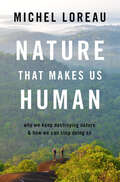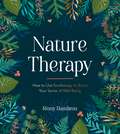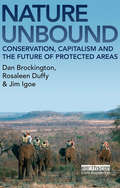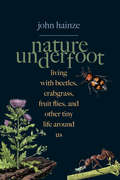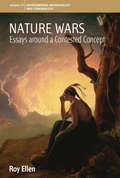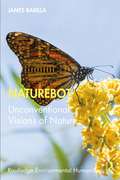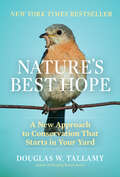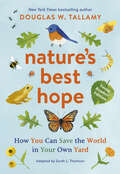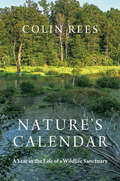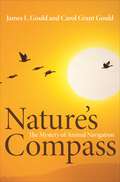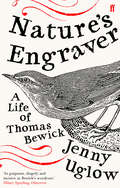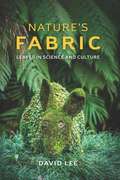- Table View
- List View
Nature That Makes Us Human: Why We Keep Destroying Nature and How We Can Stop Doing So
by Michel LoreauClimate change, biodiversity loss, pollution, resource depletion, new emerging diseases: scientists have raised awareness on the ecological and societal consequences of the unbridled development of human activities for a long time. Why do we keep destroying nature when science makes it clear that in doing so we risk our own destruction? How can we stop destroying our life-support system and reach some kind of harmony between humans and nature? This book seeks to answer these questions. It describes the inability of modern society to fundamentally modify its relationship with nature, instead engaging in collective fictions such as subject-object duality, matter-mind duality, the primacy of rationality, and the superiority of the human species over all other life. Subsequent chapters identify avenues which could allow human societies to break the current deadlock and forge a relationship with the natural world. This path is rooted in a simple observation: humans have a nature that defines them as a unique species beyond their cultural differences, and at the foundation of this nature we share a set of fundamental needs. The expression and satisfaction of these needs provide an opportunity to reconnect humans with nature in all its forms. Nature That Makes Us Human combines recent scientific discoveries in biology and psychology with deep philosophical inquiry--in addition to economic, political, and historical considerations--to understand what motivates us to keep destroying nature today and how we can engage in a new relationship with nature tomorrow. This book is for anyone interested in understanding and overcoming the current ecological crisis.
Nature Therapy: How to Use Ecotherapy to Boost Your Sense of Well-Being
by Rémy DambronNature therapy is the practice of reconnecting with the natural world to refresh your physical and mental well-being. Including tips to help you discover your connection with the outdoors, activity inspiration and a holistic approach to wellness, this book is the ultimate guide to unlocking the transformative power of nature.
Nature Unbound: "Conservation, Capitalism and the Future of Protected Areas"
by Dan Brockington Rosaleen Duffy Jim IgoeThis groundbreaking volume is the first comprehensive, critical examination of the rise of protected areas and their current social and economic position in our world. It examines the social impacts of protected areas, the conflicts that surround them, the alternatives to them and the conceptual categories they impose. The book explores key debates on devolution, participation and democracy; the role and uniqueness of indigenous peoples and other local communities; institutions and resource management; hegemony, myth and symbolic power in conservation success stories; tourism, poverty and conservation; and the transformation of social and material relations which community conservation entails. For conservation practitioners and protected area professionals not accustomed to criticisms of their work, or students new to this complex field, the book will provide an understanding of the history and current state of affairs in the rise of protected areas. It introduces the concepts, theories and writers on which critiques of conservation have been built, and provides the means by which practitioners can understand problems with which they are wrestling. For advanced researchers the book will present a critique of the current debates on protected areas and provide a host of jumping off points for an array of research avenues
Nature Unbound: "Conservation, Capitalism and the Future of Protected Areas"
by Dan Brockington Rosaleen Duffy Jim IgoeThis groundbreaking volume is the first comprehensive, critical examination of the rise of protected areas and their current social and economic position in our world. It examines the social impacts of protected areas, the conflicts that surround them, the alternatives to them and the conceptual categories they impose. The book explores key debates on devolution, participation and democracy; the role and uniqueness of indigenous peoples and other local communities; institutions and resource management; hegemony, myth and symbolic power in conservation success stories; tourism, poverty and conservation; and the transformation of social and material relations which community conservation entails. For conservation practitioners and protected area professionals not accustomed to criticisms of their work, or students new to this complex field, the book will provide an understanding of the history and current state of affairs in the rise of protected areas. It introduces the concepts, theories and writers on which critiques of conservation have been built, and provides the means by which practitioners can understand problems with which they are wrestling. For advanced researchers the book will present a critique of the current debates on protected areas and provide a host of jumping off points for an array of research avenues
Nature Underfoot: Living with Beetles, Crabgrass, Fruit Flies, and Other Tiny Life Around Us
by John HainzeAn informed and heartfelt tribute to commonly unappreciated plants, insects, and other tiny creatures that reconsiders humanity’s relationship to nature Fruit flies, silverfish, dandelions, and crabgrass are the bane of many people and the target of numerous chemical and physical eradication efforts. In this compelling reassessment of the relationship between humans and the natural world, John Hainze—an entomologist and former pesticide developer—considers the fascinating and bizarre history of how these so-called invasive or unwanted pests and weeds have coevolved with humanity and highlights the benefits of a greater respect and moral consideration toward these organisms. With deep insight into the lives of the underappreciated and often reviled creatures that surround us, Hainze’s accessible and engaging natural history draws on ethics, religion, and philosophy as he passionately argues that creepy crawlies and unwanted plants deserve both empathy and accommodation as partners dwelling with us on earth.
Nature, Value, Duty: Life on Earth with Holmes Rolston, III (The International Library of Environmental, Agricultural and Food Ethics #8)
by Christopher J. Preston Wayne OuderkirkThis is a collection of contemporary writings on the work of Holmes Rolston, III. The authors contributing to this volume are a mixture of senior scholars in environmental ethics and new voices in philosophy and in literature. Together they provide an in depth evaluation of many of the topics discussed by Rolston. Rolston himself, in a detailed reply to each of his critics at the end of the volume, reveals where some of these criticisms sting him the most.
Nature Wars: Essays Around a Contested Concept (Environmental Anthropology and Ethnobiology #27)
by Roy EllenOrganized around issues, debates and discussions concerning the various ways in which the concept of nature has been used, this book looks at how the term has been endlessly deconstructed and reclaimed, as reflected in anthropological, scientific, and similar writing over the last several decades. Made up of ten of Roy Ellen’s finest articles, this book looks back at his ideas about nature and includes a new introduction that contextualizes the arguments and takes them forward. Many of the chapters focus on research the author has conducted amongst the Nuaulu people of eastern Indonesia.
Naturebot: Unconventional Visions of Nature (Routledge Environmental Humanities)
by James BarillaNaturebot: Unconventional Visions of Nature presents a humanities-oriented addition to the literature on biomimetics and bioinspiration, an interdisciplinary field which investigates what it means to mimic nature with technology. This technology mirrors the biodiversity of nature and it is precisely this creation of technological metaphors for the intricate workings of the natural world that is the real subject of Naturebot. Over the course of the book, Barilla applies the narrative conventions of the nature writing genre to this unconventional vision of nature, contrasting the traditional tropes and questions of natural history with an expanding menagerie of creatures that defy conventional categories of natural and artificial. In keeping with its nature writing approach, the book takes us to where we can encounter these creatures, examining the technological models and the biotic specimens that inspired them. In doing so, it contemplates the future of the human relationship to the environment, and the future of nature writing in the 21st century. This book will be of great interest to students and scholars of biomimetics, environmental literary studies/ecocriticism, and the environmental humanities.
Naturebot: Unconventional Visions of Nature (Routledge Environmental Humanities)
by James BarillaNaturebot: Unconventional Visions of Nature presents a humanities-oriented addition to the literature on biomimetics and bioinspiration, an interdisciplinary field which investigates what it means to mimic nature with technology. This technology mirrors the biodiversity of nature and it is precisely this creation of technological metaphors for the intricate workings of the natural world that is the real subject of Naturebot. Over the course of the book, Barilla applies the narrative conventions of the nature writing genre to this unconventional vision of nature, contrasting the traditional tropes and questions of natural history with an expanding menagerie of creatures that defy conventional categories of natural and artificial. In keeping with its nature writing approach, the book takes us to where we can encounter these creatures, examining the technological models and the biotic specimens that inspired them. In doing so, it contemplates the future of the human relationship to the environment, and the future of nature writing in the 21st century. This book will be of great interest to students and scholars of biomimetics, environmental literary studies/ecocriticism, and the environmental humanities.
Nature's Allies: Eight Conservationists Who Changed Our World
by Larry NielsenIt’s easy to feel powerless in the face of big environmental challenges—but we need inspiration more than ever. With political leaders who deny climate change, species that are fighting for their very survival, and the planet’s last places of wilderness growing smaller and smaller, what can a single person do? In Nature’s Allies, Larry Nielsen uses the stories of conservation pioneers to show that through passion and perseverance, we can each be a positive force for change. In eight engaging and diverse biographies—John Muir, Ding Darling, Aldo Leopold, Rachel Carson, Chico Mendes, Billy Frank Jr., Wangari Maathai, and Gro Harlem Brundtland—we meet individuals who have little in common except that they all made a lasting mark on our world. Some famous and some little known to readers, they spoke out to protect wilderness, wildlife, fisheries, rainforests, and wetlands. They fought for social justice and exposed polluting practices. They marched, wrote books, testified before Congress, performed acts of civil disobedience, and, in one case, were martyred for their defense of nature. Nature’s Allies pays tribute to them all as it rallies a new generation of conservationists to follow in their footsteps. These vivid biographies are essential reading for anyone who wants to fight for the environment against today’s political opposition. Nature’s Allies will inspire students, conservationists, and nature lovers to speak up for nature and show the power of one person to make a difference.
Nature's Best Hope: A New Approach to Conservation That Starts in Your Yard
by Douglas W. TallamyAn urgent and heartfelt call for a new approach to conservation—one that starts in every backyard—from the New York Times bestselling author of Bringing Nature Home.
Nature's Best Hope (Young Readers' Edition): How You Can Save the World in Your Own Yard
by Douglas W. TallamyThis middle grade edition of the groundbreaking bestseller by Doug Tallamy will inspire kids to use their backyard to help save the planet. Douglas W. Tallamy awakened thousands of readers to an urgent situation: wildlife populations are in decline because the native plants they depend on are fast disappearing. His solution? Plant more natives. In this middle grade adaptation of the New York Times bestseller Nature's Best Hope, Tallamy outlines his vision for a grassroots approach to conservation that everyone can participate in regardless of age. In Nature's Best Hope (Young Readers' Edition), Tallamy empowers kids to use their own yards to help combat the negative effects of climate change. He does so by breaking down complex concepts into simple terms and real-world examples that kids can easily grasp. Black and white photographs help further clarify concepts. In addition to sharing the science, Tallamy encourages kids to take direct action. Some of these ideas include planting an oak tree (one of the most important tree species) at home. If that&’s too large of a task, he suggests they can plant asters—a beautiful flower whose pollen bees use to feed their young. By helping the next generation see that they have power and agency over our collective future, this empowering book will drive home the positive point that kids are truly nature&’s best hope.
Nature's Blessings
by Kirsten RiddleBe inspired by the wonderful world of nature through intentions, practical exercises and meditations for greater wellbeing and joy. We are always looking for ways to reconnect with nature. The benefits of spending time outdoors include engaging our senses and experiencing the landscape at a deeper level – but it’s not so easy to rewild and run free when we have chores and responsibilities. That’s where Nature’s Blessings can help. Kirsten Riddle will help you shift your perspective, engage with the environment and learn more about the natural world. She looks at a range of aspects of nature, from trees to rivers, sunlight to storms, butterflies to otters, and highlights ideas and positive lessons associated with each one. Arranged by the four elements, there are overall themes throughout the book: Earth is about grounding and balance; Air is about inspiration and freedom; Fire is connected to confidence and passion; Water concerns healing and self-expression. Each entry includes a daily intention, associated folklore, practical exercises to try and a closing meditation. With tips and suggestions on how you can connect with nature and the intentions at different stages during your day, you will soon be able to welcome all the blessings of nature into your life.
Nature's Burdens: Conservation and American Politics, The Reagan Era to the Present
by Daniel NelsonNature’s Burdens is a political and intellectual history of American natural resource conservation from the 1980s into the twenty-first century—a period of intense political turmoil, shifting priorities among federal policymakers, and changing ideas about the goals of conservation. Telling a story of persistent activism, conflict, and frustration but also of striking achievement, it is an account of how new ideas and policies regarding human relationships to plants, animals, and their surroundings have become vital features of modern environmentalism. In the 1960s and 1970s, Congress embraced the largely dormant movement to preserve distinctive landscapes and the growing demand for outdoor recreation, establishing an unprecedented number of parks, monuments, and recreation areas. The election of Ronald Reagan and a shift to a Republican-controlled Senate brought this activity to an abrupt halt and introduced a period of intense partisanship and legislative gridlock that extends to the present. In this political climate, three developments largely defined the role of conservation in contemporary society: environmental organizations have struggled to defend the legal status quo, private land conservation has become increasingly important, and the emergence of potent scientific voices has promoted the protection of animals and plants and injected a new sense of urgency into the larger cause. These developments mark this period as a distinctive and important chapter in the history of American conservation. Scrupulously researched, scientifically and politically well informed, concise, and accessibly written, Nature’s Burdens is the most comprehensive examination of recent efforts to protect and enhance the natural world. It will be of interest to environmental historians, environmental activists, and any general reader interested in conservation.
Nature's Calendar: A Year in the Life of a Wildlife Sanctuary
by Colin ReesFlocks of waterfowl exploding into steely skies above frozen marshland, salamanders creeping across the forest floor to vernal pools, chorusing frogs peeping their ecstasy while warblers crowd budding trees, turtles sunning on floating logs, the ecological engineering of beavers;¢;‚¬;€?these are but a few of the sights and sounds marking a year at Jug Bay Wetlands Sanctuary and its neighboring landscapes in Southern Maryland. In an absorbing account of a year in the life of this sanctuary, naturalist Colin Rees invites us to join him as he explores the secrets and wonders of the changing natural world. Alongside the author, we witness spring's avian migrations, quickening of aquatic vegetation, burgeoning of myriad invertebrates, and the assaults of extreme weather conditions. We revel in summertime's proliferation of fish, fowl, and mammals. We become attuned to the shifting climate's impacts on autumnal transitions, and we marvel at amazing feats of biological inventiveness in preparation for winter conditions. Through these visions of the fleeting;¢;‚¬;€?and yet enduring;¢;‚¬;€?cycles of nature, Rees shares deep insights into the ecological and behavioral dynamics of the natural environment. Enhanced by more than two dozen color plates, the book touches on a wide range of issues, from microbial diversity, bird banding, and butterfly phenology to genetic diversity and habitat fragmentation. It also examines the challenges of conserving these and other natural features in the face of climate change and development pressures. Thoughtful and lyrical, Nature's Calendar speaks to all readers, scientific and lay alike. Fascinating profiles of flora and fauna celebrate the richness and complexity of a unique ecosystem, exploring the entire ecology of this dynamic and delicate area.
Nature's Calendar: A Year in the Life of a Wildlife Sanctuary
by Colin ReesFlocks of waterfowl exploding into steely skies above frozen marshland, salamanders creeping across the forest floor to vernal pools, chorusing frogs peeping their ecstasy while warblers crowd budding trees, turtles sunning on floating logs, the ecological engineering of beavers;¢;‚¬;€?these are but a few of the sights and sounds marking a year at Jug Bay Wetlands Sanctuary and its neighboring landscapes in Southern Maryland. In an absorbing account of a year in the life of this sanctuary, naturalist Colin Rees invites us to join him as he explores the secrets and wonders of the changing natural world. Alongside the author, we witness spring's avian migrations, quickening of aquatic vegetation, burgeoning of myriad invertebrates, and the assaults of extreme weather conditions. We revel in summertime's proliferation of fish, fowl, and mammals. We become attuned to the shifting climate's impacts on autumnal transitions, and we marvel at amazing feats of biological inventiveness in preparation for winter conditions. Through these visions of the fleeting;¢;‚¬;€?and yet enduring;¢;‚¬;€?cycles of nature, Rees shares deep insights into the ecological and behavioral dynamics of the natural environment. Enhanced by more than two dozen color plates, the book touches on a wide range of issues, from microbial diversity, bird banding, and butterfly phenology to genetic diversity and habitat fragmentation. It also examines the challenges of conserving these and other natural features in the face of climate change and development pressures. Thoughtful and lyrical, Nature's Calendar speaks to all readers, scientific and lay alike. Fascinating profiles of flora and fauna celebrate the richness and complexity of a unique ecosystem, exploring the entire ecology of this dynamic and delicate area.
Nature's Chaos
by James GleickWith 102 spectacular full-color photos, this fascinating "field guide" explores the world's natural disorder.
Nature's Child
by Sir John Lister-KayeAs I write Hermione's twelfth year is drawing to a close. The years of innocence are waning. But we have had the good fortune to live through a period when a child's mind is wide open and as absorbent as a sponge. Blessed years of exploration and discovery, fat and full of the natural world, which surrounds her here ... the mountains and forests and ospreys, eagles, otters and pine martens of a beautiful land.' NATURE'S CHILD is John Lister-Kaye's account of bringing up his daughter to appreciate the nature around her so beloved to himself. It is also a moving meditation on that world, and on their relationship, as he shows her how caterpillars metamorphose into moths; how beavers build dams in Norway; how half a million sea birds migrate to Shetland once a year to breed; how white rhinos behave in the wilds of Swaziland; how baby polar bears are raised on an archipelago in the Arctic Ocean. As John puts it: 'Life is a collection of fragments of time charged with deeply personal sensation and meaning ... we had watched polar bears for a few minutes, but the recollection of those images are locked in for life. What is love if not time given in joy and delight?
Nature's Compass: The Mystery of Animal Navigation
by James L. Gould Carol Grant GouldWe know that animals cross miles of water, land, and sky with pinpoint precision on a daily basis. But it is only in recent years that scientists have learned how these astounding feats of navigation are actually accomplished. With colorful and thorough detail, Nature's Compass explores the remarkable methods by which animals find their way both near home and around the globe. Noted biologist James Gould and popular science writer Carol Gould delve into the elegant strategies and fail-safe backup systems, the invisible sensitivities and mysterious forces, and incredible mental abilities used by familiar and rare species, as they investigate a multitude of navigation strategies, from the simple to the astonishing. The Goulds discuss how animals navigate, without instruments and training, at a level far beyond human talents. They explain how animals measure time and show how the fragile monarch butterfly employs an internal clock, calendar, compass, and map to commence and measure the two-thousand-mile annual journey to Mexico--all with a brain that weighs only a few thousandths of an ounce. They look at honey bees and how they rely on the sun and mental maps to locate landmarks such as nests and flowers. And they examine whether long-distance migrants, such as the homing pigeon, depend on a global positioning system to let them know where they are. Ultimately, the authors ask if the disruption of migratory paths through habitat destruction and global warming is affecting and endangering animal species. Providing a comprehensive picture of animal navigation and migration, Nature's Compass decodes the mysteries of this extraordinary aspect of natural behavior.
Nature's Compass: The Mystery of Animal Navigation
by James L. Gould Carol Grant GouldWe know that animals cross miles of water, land, and sky with pinpoint precision on a daily basis. But it is only in recent years that scientists have learned how these astounding feats of navigation are actually accomplished. With colorful and thorough detail, Nature's Compass explores the remarkable methods by which animals find their way both near home and around the globe. Noted biologist James Gould and popular science writer Carol Gould delve into the elegant strategies and fail-safe backup systems, the invisible sensitivities and mysterious forces, and incredible mental abilities used by familiar and rare species, as they investigate a multitude of navigation strategies, from the simple to the astonishing. The Goulds discuss how animals navigate, without instruments and training, at a level far beyond human talents. They explain how animals measure time and show how the fragile monarch butterfly employs an internal clock, calendar, compass, and map to commence and measure the two-thousand-mile annual journey to Mexico--all with a brain that weighs only a few thousandths of an ounce. They look at honey bees and how they rely on the sun and mental maps to locate landmarks such as nests and flowers. And they examine whether long-distance migrants, such as the homing pigeon, depend on a global positioning system to let them know where they are. Ultimately, the authors ask if the disruption of migratory paths through habitat destruction and global warming is affecting and endangering animal species. Providing a comprehensive picture of animal navigation and migration, Nature's Compass decodes the mysteries of this extraordinary aspect of natural behavior.
Nature's Engraver: A Life of Thomas Bewick
by Jenny UglowThomas Bewick wrote A History of British Birds at the end of the eighteenth century, just as Britain fell in love with nature. This was one of the wildlife books that marked the moment, the first 'field-guide' for ordinary people, illustrated by woodcuts of astonishing accuracy and beauty. But it was far more than that, for in the vivid vignettes scattered through the book Bewick drew the life of the country people of the North East - a world already vanishing under the threat of enclosures.In this superbly illustrated biography, Jenny Uglow tells the story of the farmer's son from Tyneside who revolutionised wood-engraving and influenced book illustration for a century to come. It is a story of violent change, radical politics, lost ways of life and the beauty of the wild - a journey to the beginning of our lasting obsession with the natural world. Nature's Engraver won the National Arts Writers Award in 2007. Jenny Uglow is the author of, among others, A Gambling Man: Charles II and the Restoration, which was shortlisted for the 2010 Samuel Johnson Prize, Lunar Men and In These Times. 'The most perfect historian imaginable' Peter Ackroyd
Nature's Fabric: Leaves in Science and Culture
by David LeeLeaves are all around us—in backyards, cascading from window boxes, even emerging from small cracks in city sidewalks given the slightest glint of sunlight. Perhaps because they are everywhere, it’s easy to overlook the humble leaf, but a close look at them provides one of the most enjoyable ways to connect with the natural world. A lush, incredibly informative tribute to the leaf, Nature’s Fabric offers an introduction to the science of leaves, weaving biology and chemistry with the history of the deep connection we feel with all things growing and green. Leaves come in a staggering variety of textures and shapes: they can be smooth or rough, their edges smooth, lobed, or with tiny teeth. They have adapted to their environments in remarkable, often stunningly beautiful ways—from the leaves of carnivorous plants, which have tiny “trigger hairs” that signal the trap to close, to the impressive defense strategies some leaves have evolved to reduce their consumption. (Recent studies suggest, for example, that some plants can detect chewing vibrations and mobilize potent chemical defenses.) In many cases, we’ve learned from the extraordinary adaptations of leaves, such as the invention of new self-cleaning surfaces inspired by the slippery coating found on leaves. But we owe much more to leaves, and Lee also calls our attention back to the fact that that our very lives—and the lives of all on the planet—depend on them. Not only is foliage is the ultimate source of food for every living thing on land, its capacity to cycle carbon dioxide and oxygen can be considered among evolution’s most important achievements—and one that is critical in mitigating global climate change. Taking readers through major topics like these while not losing sight of the small wonders of nature we see every day—if you’d like to identify a favorite leaf, Lee’s glossary of leaf characteristics means you won’t be left out on a limb—Nature’s Fabric is eminently readable and full of intriguing research, sure to enhance your appreciation for these extraordinary green machines.
Nature's Fabric: Leaves in Science and Culture
by David LeeLeaves are all around us—in backyards, cascading from window boxes, even emerging from small cracks in city sidewalks given the slightest glint of sunlight. Perhaps because they are everywhere, it’s easy to overlook the humble leaf, but a close look at them provides one of the most enjoyable ways to connect with the natural world. A lush, incredibly informative tribute to the leaf, Nature’s Fabric offers an introduction to the science of leaves, weaving biology and chemistry with the history of the deep connection we feel with all things growing and green. Leaves come in a staggering variety of textures and shapes: they can be smooth or rough, their edges smooth, lobed, or with tiny teeth. They have adapted to their environments in remarkable, often stunningly beautiful ways—from the leaves of carnivorous plants, which have tiny “trigger hairs” that signal the trap to close, to the impressive defense strategies some leaves have evolved to reduce their consumption. (Recent studies suggest, for example, that some plants can detect chewing vibrations and mobilize potent chemical defenses.) In many cases, we’ve learned from the extraordinary adaptations of leaves, such as the invention of new self-cleaning surfaces inspired by the slippery coating found on leaves. But we owe much more to leaves, and Lee also calls our attention back to the fact that that our very lives—and the lives of all on the planet—depend on them. Not only is foliage is the ultimate source of food for every living thing on land, its capacity to cycle carbon dioxide and oxygen can be considered among evolution’s most important achievements—and one that is critical in mitigating global climate change. Taking readers through major topics like these while not losing sight of the small wonders of nature we see every day—if you’d like to identify a favorite leaf, Lee’s glossary of leaf characteristics means you won’t be left out on a limb—Nature’s Fabric is eminently readable and full of intriguing research, sure to enhance your appreciation for these extraordinary green machines.
Nature's Fabric: Leaves in Science and Culture
by David LeeLeaves are all around us—in backyards, cascading from window boxes, even emerging from small cracks in city sidewalks given the slightest glint of sunlight. Perhaps because they are everywhere, it’s easy to overlook the humble leaf, but a close look at them provides one of the most enjoyable ways to connect with the natural world. A lush, incredibly informative tribute to the leaf, Nature’s Fabric offers an introduction to the science of leaves, weaving biology and chemistry with the history of the deep connection we feel with all things growing and green. Leaves come in a staggering variety of textures and shapes: they can be smooth or rough, their edges smooth, lobed, or with tiny teeth. They have adapted to their environments in remarkable, often stunningly beautiful ways—from the leaves of carnivorous plants, which have tiny “trigger hairs” that signal the trap to close, to the impressive defense strategies some leaves have evolved to reduce their consumption. (Recent studies suggest, for example, that some plants can detect chewing vibrations and mobilize potent chemical defenses.) In many cases, we’ve learned from the extraordinary adaptations of leaves, such as the invention of new self-cleaning surfaces inspired by the slippery coating found on leaves. But we owe much more to leaves, and Lee also calls our attention back to the fact that that our very lives—and the lives of all on the planet—depend on them. Not only is foliage is the ultimate source of food for every living thing on land, its capacity to cycle carbon dioxide and oxygen can be considered among evolution’s most important achievements—and one that is critical in mitigating global climate change. Taking readers through major topics like these while not losing sight of the small wonders of nature we see every day—if you’d like to identify a favorite leaf, Lee’s glossary of leaf characteristics means you won’t be left out on a limb—Nature’s Fabric is eminently readable and full of intriguing research, sure to enhance your appreciation for these extraordinary green machines.
Nature's Fabric: Leaves in Science and Culture
by David LeeLeaves are all around us—in backyards, cascading from window boxes, even emerging from small cracks in city sidewalks given the slightest glint of sunlight. Perhaps because they are everywhere, it’s easy to overlook the humble leaf, but a close look at them provides one of the most enjoyable ways to connect with the natural world. A lush, incredibly informative tribute to the leaf, Nature’s Fabric offers an introduction to the science of leaves, weaving biology and chemistry with the history of the deep connection we feel with all things growing and green. Leaves come in a staggering variety of textures and shapes: they can be smooth or rough, their edges smooth, lobed, or with tiny teeth. They have adapted to their environments in remarkable, often stunningly beautiful ways—from the leaves of carnivorous plants, which have tiny “trigger hairs” that signal the trap to close, to the impressive defense strategies some leaves have evolved to reduce their consumption. (Recent studies suggest, for example, that some plants can detect chewing vibrations and mobilize potent chemical defenses.) In many cases, we’ve learned from the extraordinary adaptations of leaves, such as the invention of new self-cleaning surfaces inspired by the slippery coating found on leaves. But we owe much more to leaves, and Lee also calls our attention back to the fact that that our very lives—and the lives of all on the planet—depend on them. Not only is foliage is the ultimate source of food for every living thing on land, its capacity to cycle carbon dioxide and oxygen can be considered among evolution’s most important achievements—and one that is critical in mitigating global climate change. Taking readers through major topics like these while not losing sight of the small wonders of nature we see every day—if you’d like to identify a favorite leaf, Lee’s glossary of leaf characteristics means you won’t be left out on a limb—Nature’s Fabric is eminently readable and full of intriguing research, sure to enhance your appreciation for these extraordinary green machines.
